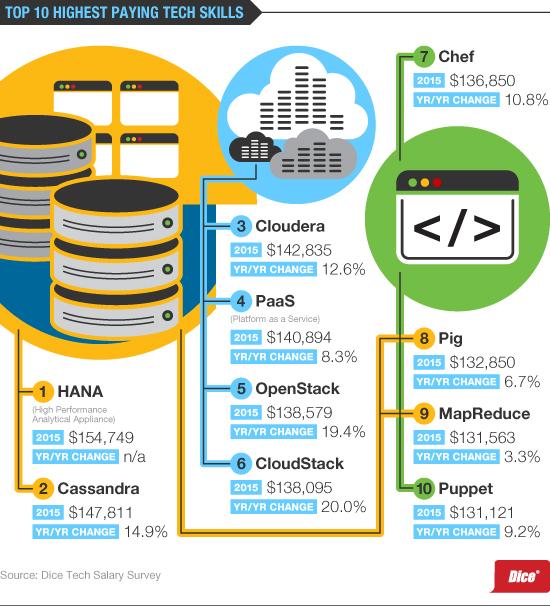The average technology salary in the U.S. leapt 7.7 percent in 2015, according to the latest Dice Salary Survey. But which technologies and skillsets drew the highest payouts? Short answer: anything to do with data-wrangling.
Dice’s data suggests that, if you specialize in storage, data analytics, or database management, you can expect to earn a hefty paycheck. Scan the following list and see how the various skillsets performed:
SAP HANA
2015 Salary: $154,749
SAP’s in-memory database management system is designed to rapidly handle high transaction rates and complex query processing. For years, SAP positioned the technology as its competitive differentiator in the highly aggressive database market, adding features such as an embedded Web server and a version control repository. Some enterprises use the HANA platform in conjunction with server-side JavaScript and HTML to create applications.
SAP’s biggest rivals, including Oracle and IBM, have their own in-memory offerings; more startups are also pushing into database software, making the market extra-complicated for SAP as it attempts to stand out.
Cassandra
2015 Salary: $147,811
Cassandra has long hovered near the top of highest-paying analytics technologies, outpacing the likes of MapReduce and Cloudera in some surveys.
From a tech-pro perspective, Cassandra provides quite a bit of utility; the open-source database-management system can wrangle data across multiple servers and datacenters, all with low latency. The platform’s popularity has rapidly increased over the past few years, as more database administrators rely on it to rapidly scale their data needs.
Cloudera
2015 Salary: $142,835
Cloudera (the software company) offers software and services based on Apache Hadoop, including its own Hadoop distribution, CDH. For those who don’t know, Apache Hadoop is an open-source framework that allows tech pros to run data applications on large hardware clusters; as its popularity has increased over the past few years, several companies have stepped forward with unique Hadoop distributions to serve specialized tech audiences.
PAAS
2015 Salary: $140,894
PAAS stands for Platform-as-a-Service. In contrast to SAAS (Software-as-a-Service) or IAAS (Infrastructure-as-a-Service), PAAS revolves around the cloud-based deployment of applications and/or services without the need to build out a datacenter or buy localized software. As more and more businesses migrate to the cloud, PAAS and other services become exponentially more important.
Up Next: OpenStack, CloudStack, Chef, Pig (click below)

OpenStack
2015 Salary: $138,579
OpenStack is often used in conjunction with IAAS (Infrastructure-as-a-Service) deployments, as a way to better manage processing, storage, and networking resources. It’s an open-source technology.
If you’re interested in pursuing OpenStack as a career path (or just landing a job that utilizes the technology), check out Dice’s interview questions for OpenStack developers.
CloudStack
2015 Salary: $138,095
Database administrators and cloud architects use CloudStack to create and deploy infrastructure-cloud services. On the hypervisor front, it incorporates vSphere, XenServer/XCP, and KVM; there’s also (perhaps inevitably) support for the Amazon Web Services (AWS) API.
Chef
2015 Salary: $136,850
The buzz around Chef, a configuration-management tool written in Ruby and Erlang, has been rising for some time. System administrators and cloud architects use the platform to help define what newly provisioned servers should do. Chef’s popularity also stems in part from rising interest in automated processes, as it helps those admins configure systems or deploy software without human assistance.
Pig
2015 Salary: $132,850
Another platform utilized in conjunction with Hadoop, Pig gives tech pros the tools for creating MapReduce programs via a specialized language (Pig Latin). The platform has its origins in Yahoo’s research division, where it was created as a way of executing MapReduce jobs on huge datasets.
Up Next: MapReduce, Puppet (click below)

MapReduce
2015 Salary: $131,563
A programming model for processing large datasets in parallel, MapReduce is a vital tool for database administrators, data scientists, and other tech pros tasked with storing and processing huge mountains of data, so no wonder employers are willing to pay top dollar for those with the skill. As with other data-related skills on this list (such as Cloudera and Cassandra), MapReduce has regularly commanded high salaries in tech-pro surveys.
Puppet
2015 Salary: $131,121
An open-source configuration management utility, Puppet is relatively old by technology standards, having recently celebrated its tenth birthday. That being said, the platform isn’t ready for the retirement home just yet: system administrators and tech pros still need it to configure both Windows and Unix systems, and it’s known for its cross-platform capabilities, including support for Debian, Ubuntu, SUSE, and Oracle Linux.
For those interested in learning the technology, the Puppet Professional Certification costs $200 (and requires a 90-minute exam with 60 multiple-choice questions). Certified Puppet experts understand Puppet IT automation software, and can develop basic modules, including data separation and external data sources. If you decide to specialize in the technology, here are interview questions you might face while looking for a job.



